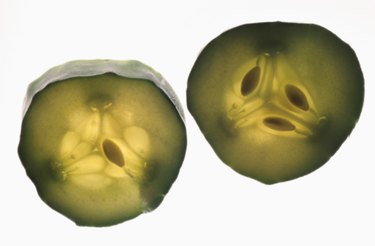
From dill to sweet gherkin, myriad pickle recipes abound, with ingredients from garlic and chili peppers to brown sugar and honey. The common ingredient in just about every pickle recipe, however, is vinegar. White distilled vinegar is a trusty standby that can be used in most any pickle recipe. You can change it up a little, though, by using apple cider vinegar instead.
Flavor
Video of the Day
The main difference between pickling with white vinegar and apple cider vinegar is the flavor. Distilled from ethyl alcohol, white vinegar, also called distilled vinegar or white distilled vinegar, lends that classic tartness to pickles. Apple cider vinegar, made, of course, from apple juice or apple cider, has a sweeter, more mellow flavor with hints of fruitiness. It works well with spices and is perfect for sweet recipes bread and butter pickles.
Video of the Day
Color
White vinegar is clear, so it won't affect the color of cucumbers or most other vegetables. Apple cider vinegar, on the other hand, will likely impart its brownish color onto whatever it's used to pickle.
Acidity
Both white and apple cider vinegar generally come at 5 percent acidity. This is crucial for most pickle recipes. Always check the bottle, particularly of the apple cider vinegar, which does come at 4 percent acidity from time to time.
Blend
Use a blend of both vinegars (if they are both at 5 percent) to get the best of white vinegar's tartness and apple cider's sweetness. Be aware that even a blend will still likely discolor the pickles.